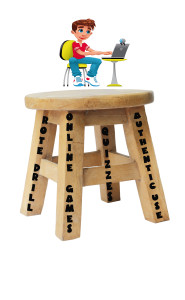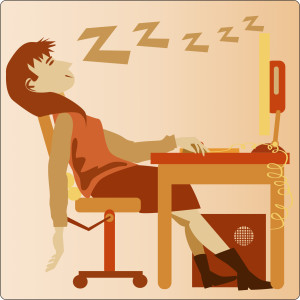Drills have backstopped keyboarding since I was in high school. I still remember
rtyu
fghj
vbnm
Over and over I typed those until my fingers could find the keys with no help from my brain. It worked for thousands of us.
So why don’t drills work for the new generation of typists. There are a few reasons:
- Kids are learning keyboarding at a younger age. Where I started training in high school, now I teach pre-keyboarding to students as young as kindergarten. Drills simply aren’t the right approach for those younger brains.
- Drills must be repeated over and over ad nauseum to work. Few schools have time to commit to that rigor and even fewer kids will voluntarily take time at home. As a result, the repetitive part of drill is no longer exercised.
As a result, it didn’t surprise me when I got this letter from one of my readers:
I teach K-6 computers. I teach keyboarding in all grade levels, 3/4 specifically. However, I see this as a giant hurdle. When I teach keyboarding skills–home row, posture, finger placement and use of our online software–the kids get it! They really get it. I walk around the lab and they are using the software, the fingering is good. WPM are great, errors are down. But when I test them in Word processing, their fingering is terrible. Their errors go up and their fingering resorts back to hunt and peck. What gives? Every child, every grade level, every day of the year. Someone please tell me I am not the only one.
I hear this over and over again: Teachers invested in a sequenced keyboarding program. The weekly drills resulted in faster more accurate typing in the native program, but didn’t transfer to homework and projects.
Here’s why: Rote drills are only one leg of a four-legged stool that supports keyboarding literacy. Here’s what else you need:
Online games
Yes, that’s right. Games. About 20% of keyboard practice should be typing games like Nitro Type. This keeps repetitive drills from getting boring and makes keyboard practice fun. Mix ggames inwith other keyboarding routines.
Quizzes
Give students at least one quiz each grading period, to let them measure their success. Make a big deal out of scores, improvement, and how close students get to grade-level goals. Post fastest typists–and fastest average class–on the wall in the classroom. I grade students on improvement, not how they compare to other students. First, students get to see they are improving, and second, for those who are competitive, they get measurable goals throughout the year.
Authentic Use
Require typing in classwork and homework. Remind students that–as they type the book report–they use good posture and habits. Get all the teachers on the grade-level team involved, as well as parents, so wherever students are typing, someone gently reminds them to use good habits. Once these are established, it’s muscle memory, like kicking a soccer ball with the side of your foot.
- It gets boring; students mentally fall asleep
- It doesn’t reflect reality. Nowhere in preparation for college or career are students asked to type home row ten times while goofy music plays in the background
Don’t leave this article planning to exorcise drills from your keyboarding program. Far from it. The distinguished education reformer, E. D. Hirsch Jr., considers it “helpful in making the procedures second nature, which allows you to focus on the structural elements of the problem.” Keep drill as one leg in your keyboarding program, as essential as smell is to a good recipe. Just not the only ingredient.
Jacqui Murray has been teaching K-18 technology for 30 years. She is the editor/author of over a hundred tech ed resources including a K-12 technology curriculum, K-8 keyboard curriculum, K-8 Digital Citizenship curriculum. She is an adjunct professor in tech ed, Master Teacher, webmaster for four blogs, an Amazon Vine Voice, CSTA presentation reviewer, freelance journalist on tech ed topics, contributor to NEA Today, and author of the tech thrillers, To Hunt a Sub and Twenty-four Days. You can find her resources at Structured Learning.






































Thanks for this information and for the “31 Keyboarding Websites” list. In searching through the websites listed (and searching further online), I am unable to find an online quiz suitable for K-2 students (most of the quizzes seem very overwhelming from the get-go for a kindergartner, first or second grader. Can you, or anyone suggest a simpler typing test online (maybe one that I could print the results from too?)?
I’m looking for something that I can use to track student progress at 3-4 different points throughout the year (but I am at a K-2 building). Thanks for your help and advice!
My favorite for K/1 is Brown Bear Typing. It focuses on key placement, nothing else, which is perfect for pre-keyboarders. I show them how to use the site (first time only), then set a goal of, say 20 (that’s typing 20 correct keys in 30 seconds. I purposely make it high for over-achievers). Every 3 minutes, I lower the goal until all students can pass it. Those who finish are proud of their accomplishment and rewarded with fun inquiry-based websites (to tie into class inquiry). This is highly popular with my students and they often choose to ‘practice’ during free time.
2nd grade–I assess them anecdotally only–posture, hand position, tenacity. That sort. You could use Brown Bear, though. Many of my 2nd graders love revisiting the good memories from K/1
Thank you! I really appreciate you taking the time to share your advice!
🙂
When you say that 20% of keyboarding practice should be games, is this before students have learned where all the keys are located? My students always ask to play the games but quickly give up proper keyboarding to search for keys. Wouldn’t that teach them to hunt and peck?
Ah–that’s the secret: They can play games, but must use correct keyboarding skills. Because they want this treat, they are more likely to work harder at good habits.
Thank you! I appreciate your input!
Using the Almena Method DVD the children learn the keyboard mapping and the correct finger placement in One 20 minute session. For children this young It they may have to watch it twice :).
Once memorize the keyboard they can type any letter, word and sentence.
I like that. It leaves more time for other, more authentic exercises (more authentic than drills–though I consider those a necessary piece of learning keyboarding).